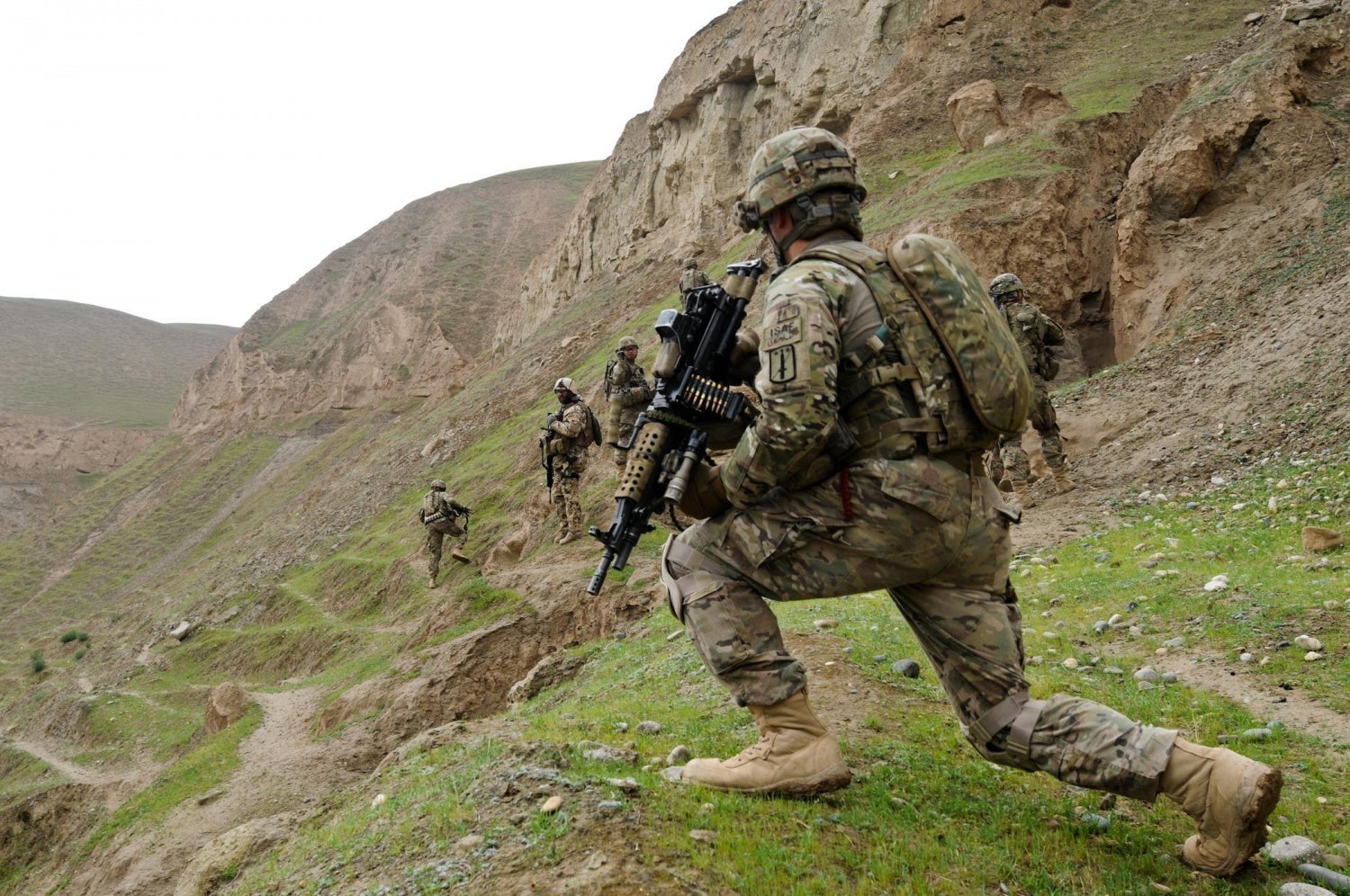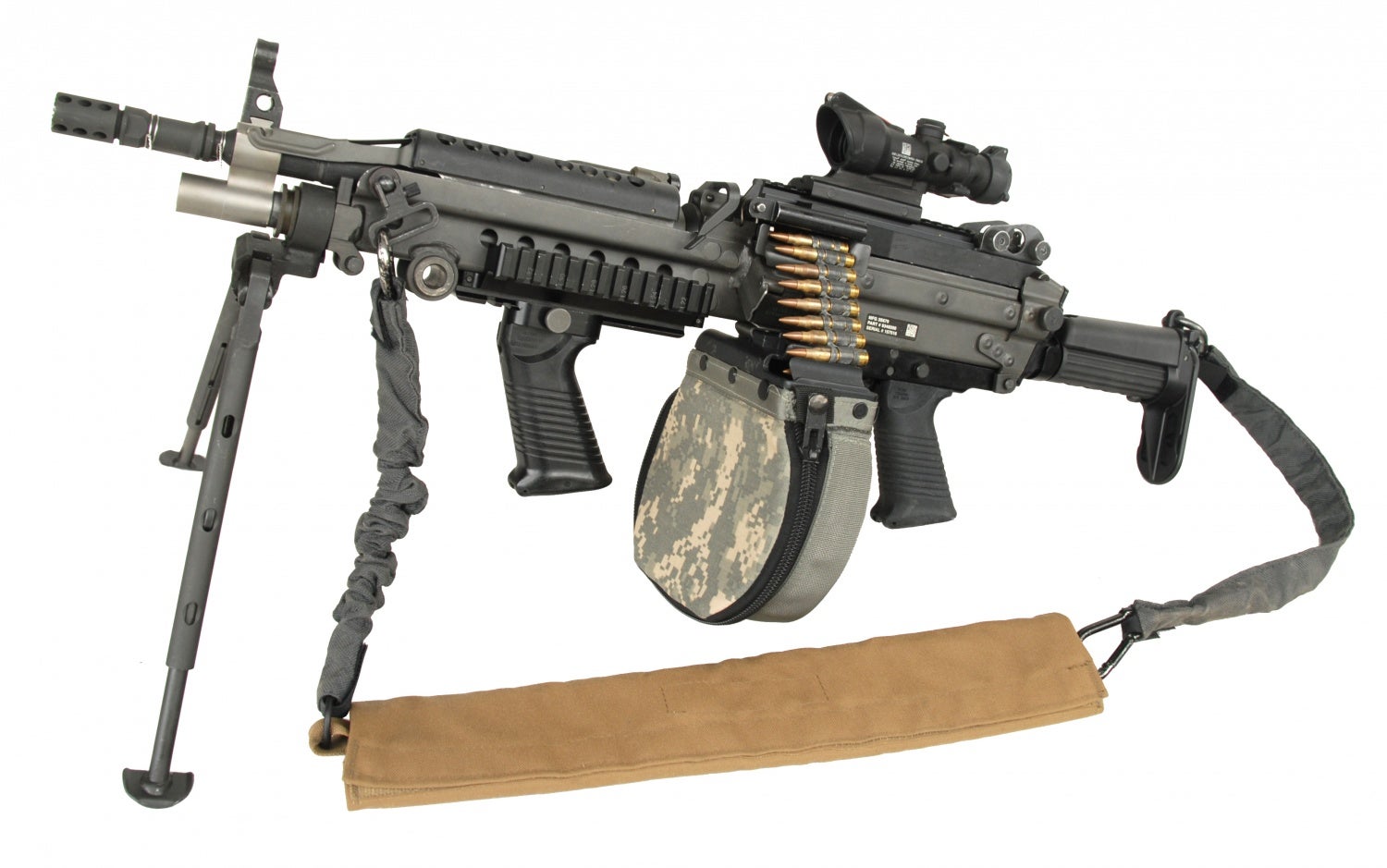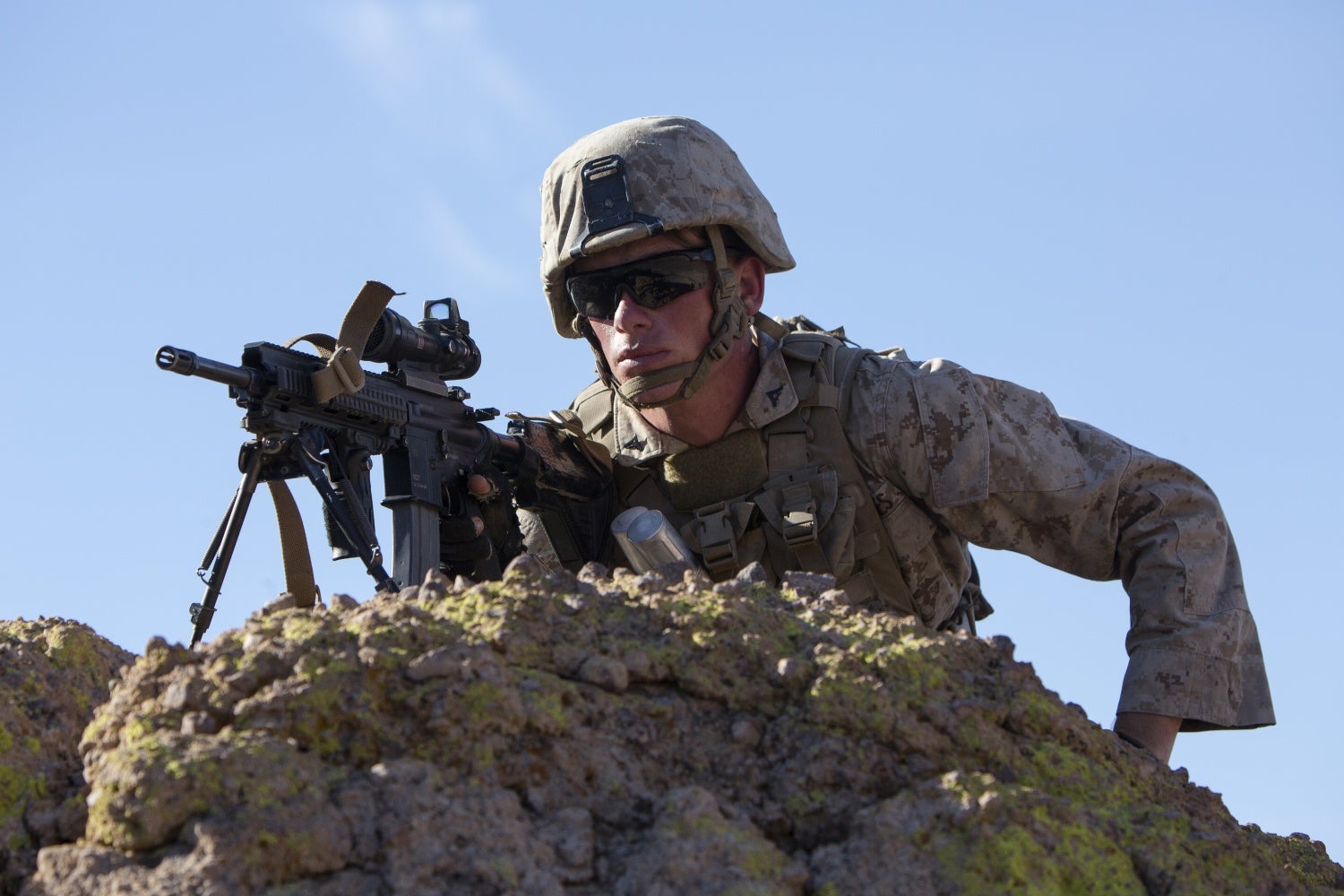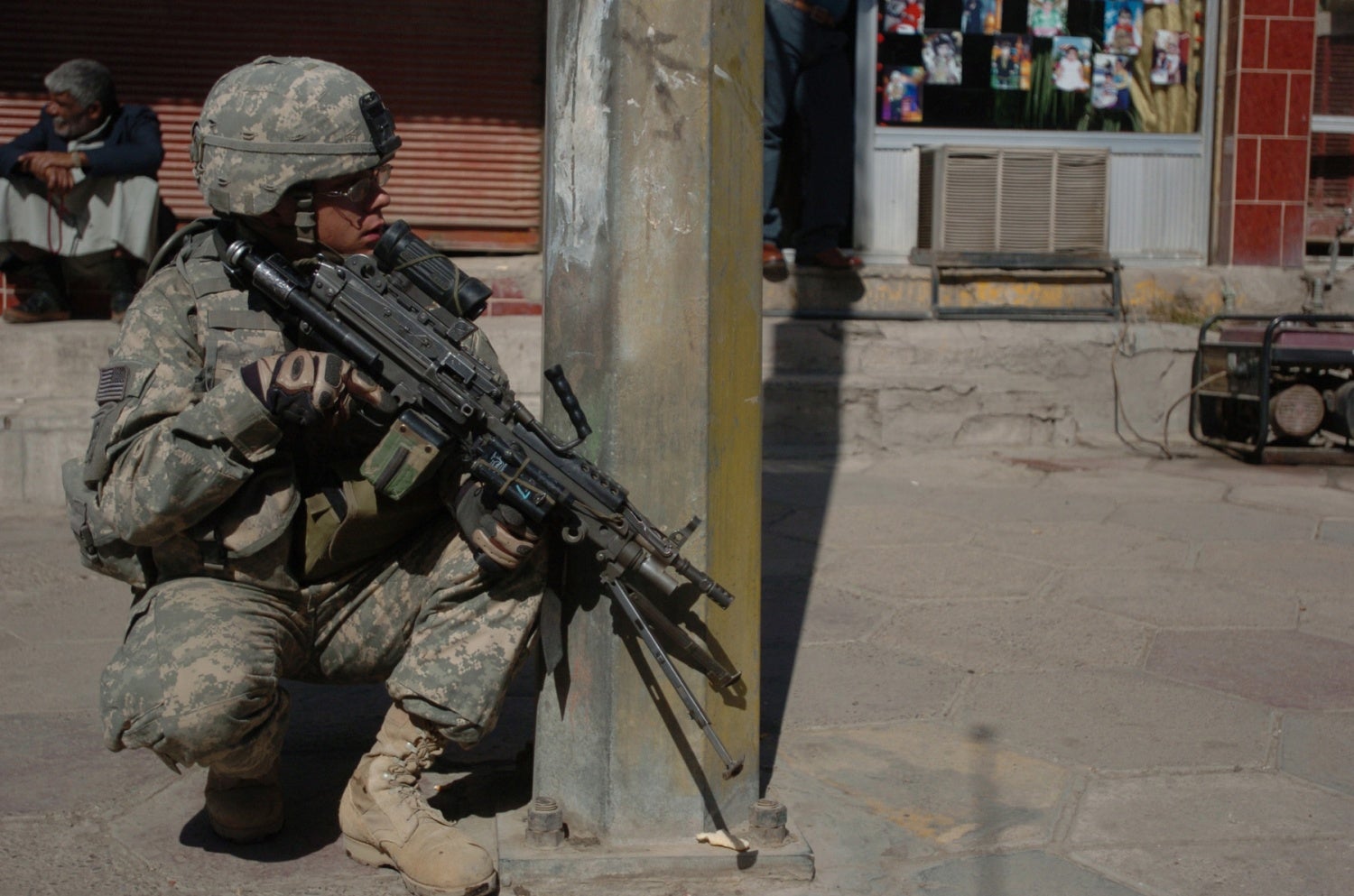Whatever the next infantry small arms configuration is, I hope it does away with the failure that is the belt-fed Squad Automatic Weapon (SAW). Why? Let’s talk about it.
On the surface, the idea of augmenting the firepower of a rifle squad with a belt-fed machine gun makes a good deal of sense: The feeding mechanism of the belt-fed means that many, many more rounds can be fired before the gun needs to be reloaded. The M249 itself is famous for its 200 round belt-in-box magazines which clip under the gun, and provide continuous firepower that a magazine-fed weapon simply would be unable to match. In theory, the addition of a weapon like this to the rifle squad should substantially augment small unit firepower and flexibility – especially on the defense where SAWs can be used to provide interlocking fires. And in theory, the SAW can be used like a rifle, too, so it’s win-win, right? Well, theory is different than practice – in this case, very different.

Original caption: “Spc. Mustafa H. Valadanzouj, a San Antonio native, now an M249 machine-gunner with 3rd Platoon, A Company, 2nd Battalion, 18th Infantry Regiment, 170th Infantry Brigade Combat Team along with other 3rd Platoon soldiers survey an area near Gerdab, Afghanistan, April 14, 2011.” US Army photo by SPC Nathan Goodall, public domain.
One of the primary shortcomings of the SAW concept lies in the way target suppression works, and the weight-limited nature of the rifle squad. Fundamentally, the belt-fed SAW is a volume of fire weapon which achieves target suppression via probability. Put simply, more bullets flying means a higher chance to hit, and a higher chance to get close enough to keep the bad guys’ heads down. Thanks to its open bolt and interchangeable barrels, however, the SAW trades the rifle’s ability to make precise shots that suppress much more efficiently, for the absolute maximum possible fire volume. This makes the SAW an incredibly wasteful weapon that burdens the the squad with (literally) thousands of rounds of extra ammunition needed just to feed the two belt-feds. The rifle squad fireteam (4 men) of the United States Marine Corps is very similar to that of the US Army fireteam, with one exception: Where the US Army uses SAWs, the USMC instead employs a magazine-fed automatic rifle, the M27 IAR. The USMC automatic rifleman (AR) typically carries 11 magazines, and the other Marines in his fireteam carry 7 a piece. In the Army’s arrangement, each rifleman carries the same 7 magazine loadout, but on top of that they carry 200 round belts for the SAW, while the Army SAW gunner himself carries nearly 800 rounds of linked ammunition to feed his thirsty weapon. This additional ammunition amounts to an average increase of 3 kilograms (6.6 pounds) per soldier, or about 100%, in the US Army rifle squad fireteam, versus the USMC fireteam – a weight penalty equivalent to pure-fleeting 7.62 NATO rifles! Therefore, the abandonment of the SAW in favor of the much more efficient automatic rifle would result in substantial reductions in weight carried, while maintaining effectiveness through much greater precision of fire and much more judicial application of the fully automatic fire mode.
Further, although the average weight increase is 3 kg, the local weight increase for the automatic rifleman alone is far higher, especially when the weapon itself is considered. In ammunition alone, the Marine automatic rifleman carries almost 6 kilograms (13.2 pounds) less than his Army counterpart. His weapon, too, is far lighter – unloaded, by 4.4 kilograms (9.6 pounds); loaded (with a 100 round soft pack) by over 6 kilograms (13.3 pounds). This means the total load of the USMC automatic rifleman is 10.4 kilograms (22.8 pounds) less than that of the Army SAW gunner – nearly as much as he carries in body armor! A lighter automatic rifleman is more mobile, less vulnerable, and less prone to injury, this last being most critical for the heaviest laden member of the rifle squad.

In this “improved” configuration, the M249 LMG weighs nearly 26 pounds (11.6 kg) loaded. The load of US Army SAW gunners often exceeds 50 pounds in weapon and ammunition alone. US Army photo, public domain.
Mobility may not seem as important for a role that is seen as supporting the squad, but ultimately it is one of the key shortfalls of the SAW concept. A belt-fed weapon is not only much heavier, but its ammunition handling is far inferior, and it is much more prone to jams when used as an organic squad weapon than the rifle. Exposed belts drag in debris from the environment, open bolts and open top covers (necessary when reloading) allow dust and filth into the weapon’s chamber. In a 2006 study on soldier weapon reliability, the M249 SAW was rated the least reliable individual weapon in the US Army inventory, and soldiers reported that stoppages with the M249 more than any other weapon had a large impact on the battle due to the time it took to clear them. This means that the SAW gunner must stop and clear malfunctions much more often than his teammates, and that weapon administrations are much more difficult, and take longer. Because of this, the SAW gunner often has difficulty keeping up with his fireteam, resulting in the unit being “tethered” to his position. Therefore, the mobility of not only the automatic rifleman is reduced by the SAW, but the mobility of the entire unit. Like the proverbial herd of buffalo, a squad can only move as fast as its slowest member.
In the video below, a USAF JTAC engages the enemy with a 7.62mm Mk. 48 machine gun, a close relative of the Minimi. Note the large amount of downtime of the weapon during reloading, and how difficult it is for the gunner administer the weapon by himself in combat. The gunner has become completely task saturated.
For the squad, flexibility is as important for mobility, yet the SAW is a single-purpose weapon. It cannot function as a designated marksman’s rifle, due to its heavy weight, open bolt, and insufficiently rigid optics mounting rail. So, another member of the team must take up that role. At the same time, the SAW cannot be a very good entry or CQB weapon, due to its lengthy reload, bulk, and propensity for snagging. To compensate, the SAW gunner may either carry a pistol or even a carbine, further increasing weight. In contrast to the SAW, to both of these tasks the magazine-fed automatic rifle is well-suited. It is nearly as small if not as small as a carbine, shares the same magazines, and it can be made as accurate as any purpose-built DMR. At both long range and the critical closing phase of battle, the magazine-fed automatic rifle maintains a very high degree of effectiveness, while the SAW does not. In addition, a belt-fed SAW by necessity will be a radically different design than the standard rifle. A magazine-fed automatic rifle, on the other hand, may be either based on and share parts with the infantry rifle, as in the Russian RPK, or the infantry rifle itself may serve both functions, as the M16A1 did prior to the M249’s introduction.

Due to its inherently superior accuracy, a closed-bolt magazine-fed automatic rifle can serve double duty as a DMR, where a SAW cannot. Original caption: “U.S. Marine Corps Lance Cpl. James B. Money, an automatic rifleman with Charlie Company, 1st Battalion, 8th Marine Regiment, 2nd Marine Division (MARDIV), provides security for his company in a mechanized assault during Integrated Training Exercise 1-16 aboard Marine Corps Air Ground Combat Center, Twentynine Palms, Calif., Oct. 27, 2015.” USMC photo by 1st Lt. Kathleen Kochert, public domain.
Reservations about the magazine-fed automatic rifle are unfounded, as well. The SAW’s most obvious advantage versus its mag-fed counterpart is, of course, ammunition capacity. 200 rounds beats 30, or so the logic goes. In reality, however, a 200 round soft pack is extremely heavy, about 3 kilograms (6.7 pounds) by itself. This makes a gun that is already difficult to maneuver and carry even more cumbersome. For this reason, often 100 round and 50 round soft packs are preferred over the 200 round boxes and soft packs, reducing this advantage by up to three-fourths. On the other hand, the significantly higher accuracy of a closed-bolt automatic rifle gives similar effectiveness to the belt-fed, open-bolt SAW, while using far less ammunition. USMC testing preceding the initiation of the Infantry Automatic Rifle program showed that a much more accurate weapon could achieve the same target effect as the M249, while using as little as 1/3rd the ammunition – a huge boon for weight-strapped infantry units.

SAW gunners often carry 100-round soft packs to reduce weight, halving their ammunition capacity. Original caption: “Lubbock, Texas, native Pfc. Jason Bates, 21, a saw gunner with 2nd Platoon, Company A, 1st Battalion, 325th Airborne Infantry Regiment, 2nd Brigade Combat Team, 82nd Airborne Division, which is attached to 2nd BCT, 1st Inf. Div. pulls security in the Hurriyah neighborhood of the Kadhimiya district of Baghdad Feb. 8, 2007.” US Army photo by SPC Cal Turner, public domain.
To close with and destroy the enemy through fire and maneuver is the mission of the Infantry in both services – yet the SAW concept is detrimental to that mission. Although it is capable of prodigious firepower, it sacrifices key characteristics of individual weapons to achieve it, and in doing so becomes something that is neither fish nor fowl. It is too heavy, cumbersome, and finicky to be a good individual weapon, and its caliber is too small to serve as a very good crew-served machine gun. Therefore it exists in a space where it is neither one nor the other. No wonder the Russians tried the concept with the RPD, and abandoned it after less than a decade, never to go back. No wonder the Marines traded most of their SAWs for IARs, and are now ordering more IARs to replace the last of the M249s in service.
Maybe it’s time for the Army to give up the SAW, too.
 Your Privacy Choices
Your Privacy Choices
